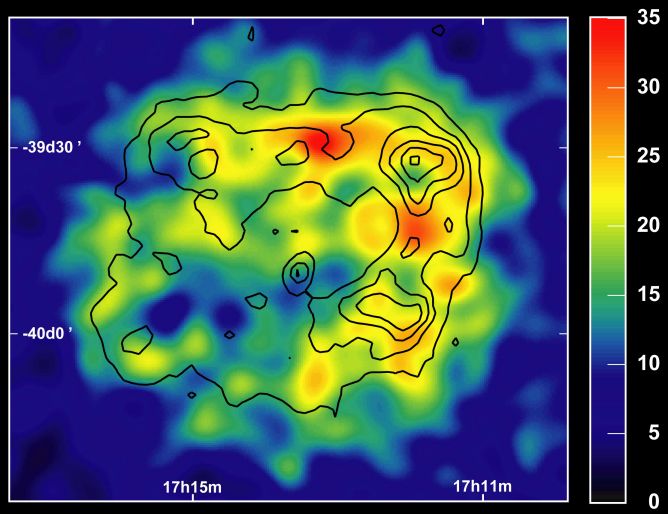Credit & Copyright: HESS Collaboration -
image courtesy Werner Hofmann
(MPI)
Explanation:
Gamma rays are the most energetic
form of light.
With up to a billion times the energy of ordinary "medical"
x-rays,
they easily penetrate telescope lenses and mirrors, making it
very difficult to create
gamma-ray images of cosmic sources.
Still, an array of large telescopes
designed to detect gamma-ray
induced atmospheric flashes - the HESS
(High Energy
Stereoscopic System)
experiment - has produced this historic, resolved image of a
supernova remnant at extreme
gamma-ray energies.
Astronomers note that the
premier
gamma-ray view of the expanding
stellar debris cloud is clearly similar to x-ray images of the remnant
and convincingly supports the idea that these sites of powerful
shock waves are also sources of cosmic
rays within our galaxy.
The gamma-ray intensity is color-coded in the picture, shown with
dark contour lines that trace levels of x-ray emission
from the object.
At an estimated distance of 3,000 light-years, the supernova
remnant measures about 50 light-years across and
lies near the galactic plane.
1999 2000 2001 2002 2003 2004 2005 2006 2007 2008 2009 2010 2011 2012 2013 2014 2015 2016 2017 2018 2019 2020 2021 2022 2023 2024 2025 |
Yanvar' Fevral' Mart Aprel' Mai Iyun' Iyul' Avgust Sentyabr' Oktyabr' Noyabr' Dekabr' |
NASA Web Site Statements, Warnings, and Disclaimers
NASA Official: Jay Norris. Specific rights apply.
A service of: LHEA at NASA / GSFC
& Michigan Tech. U.
|
Publikacii s klyuchevymi slovami:
supernova remnant - ostatok Sverhnovoi - gamma ray - gamma-izluchenie - cosmic rays
Publikacii so slovami: supernova remnant - ostatok Sverhnovoi - gamma ray - gamma-izluchenie - cosmic rays | |
Sm. takzhe:
Vse publikacii na tu zhe temu >> | |
